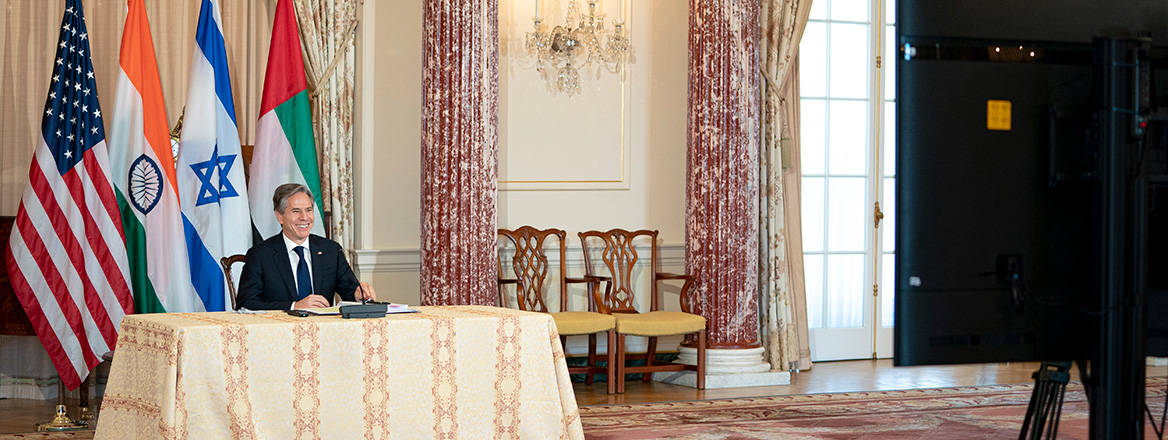As geopolitical shifts unfold across the Western Indian Ocean, the coming together of a new grouping of countries with similar interests is likely to facilitate greater engagement with the region.
On 18 October, the foreign ministers of India, Israel, the US and the UAE held a meeting and formed a joint working group. The meeting discussed expanding political and economic cooperation between the four partners in West Asia and Asia more broadly. The discussion focused on areas such as climate change, maritime security, trade and energy cooperation, and public health. The coming together of these four partners is being dubbed as the 'new' Quad.
Geopolitical realities are never static, and shifts in the balance of power challenge old assumptions. Therefore, countries routinely adjust their strategies and find partners appropriate for responding to the evolving structure of the strategic environment. The ‘new’ Quad seeks to address the changing geopolitics of West Asia as well as the Western Indian Ocean (WIO).
The ‘old’ Quad between India, the US, Japan and Australia is focused on managing the rise of China and is naturally oriented towards the Eastern Indian Ocean and Western Pacific. However, in the WIO, until now there has been no such politico-security arrangement that would bring together countries sharing interests and similar threat perceptions. The ‘new’ Quad seeks to fill this gap.
The WIO, the region lying between India, the Suez Canal and South Africa, is strategically critical as it contains the key maritime chokepoints of the Bab-el-Mandeb and the Suez Canal. In 2018, nearly 6.2 million barrels of oil flowed through the Bab-el-Mandeb every day towards Asia and Europe. Sea lanes passing through the region are a critical node in the global energy network as well as economic security dynamics.
The presence of interconnected threats such as maritime piracy, illegal smuggling of drugs and weapons, and terrorism heightens the strategic importance of the region. Regional states host military bases of major powers including China, Russia, Japan and France, making it an arena of major power contestation.
The presence of interconnected threats such as maritime piracy, illegal smuggling of drugs and weapons, and terrorism heightens the strategic importance of the region
In this context, a minilateral working group of key regional and global players was long overdue. Unlike the 'old' Quad, the ‘new’ Quad is not directed against any particular threat. It is likely to be a flexible arrangement and is made possible by a convergence of interests in both the bilateral and regional dimensions.
In the last few years, bilateral engagement between India, Israel and the UAE has grown significantly. India has shed past inhibitions over engaging with Israel and is now investing considerable political capital in enhancing the relationship. Israel is emerging as a key partner in domains such as security, technology, energy and agriculture.
India’s political outreach to the UAE is considered as one of the success stories of its foreign policy. The Gulf state was always a key economic and energy partner for India, but has now emerged as a close strategic partner as well.
Another building block of the ‘new’ Quad is the strengthening of ties between the UAE and Israel. The Abraham Accords, facilitated by the US, resulted in the establishment of diplomatic relations between the UAE and Israel last year. These states share concerns about terrorism, Iran’s regional behaviour and its nuclear programme.
Apart from the bilateral dimension, there is a broader, regional security dimension to the ‘new’ Quad. In the last few years, the strategic activities and interest of these four countries in the WIO have increased significantly.
Forming the Western flank of the Indo-Pacific region, the WIO is fast emerging as a strategic theatre in its own right, as well as being a part of the geopolitics of the Indo-Pacific. India, Israel, the US and the UAE are key players in the WIO and have stakes in shaping the emerging political and security order in the region.
A minilateral working group of key regional and global players in the Western Indian Ocean was long overdue
The war in Yemen and intra-Gulf rivalries have been a significant contributing factor in shaping the geopolitics of the WIO. As a result, the UAE has assertively engaged with the region and projected its growing power into both the continental and maritime space of the Red Sea and the Gulf of Aden.
Israel has reportedly established listening posts in Eritrea as well as on the island of Socotra. The strengthening of ties between the UAE and Israel opens up possibilities of working together in the WIO with close strategic partners such as India, France and the US.
On account of their naval presence and strategic engagement, India and the US are important players in the WIO. In fact, the WIO is considered as an ‘area of interest’ for the Indian Navy. In view of the growing Chinese presence in the region, India and the US are boosting their partnership in the WIO.
The interests and capabilities of all four countries are complementary to each other. Therefore, the ‘new’ Quad is likely to facilitate greater engagement with the region and maximise their strategic options.
The views expressed in this Commentary are the author’s, and do not represent those of RUSI or any other institution.
Have an idea for a Commentary you’d like to write for us? Send a short pitch to commentaries@rusi.org and we’ll get back to you if it fits into our research interests. Full guidelines for contributors can be found here.


